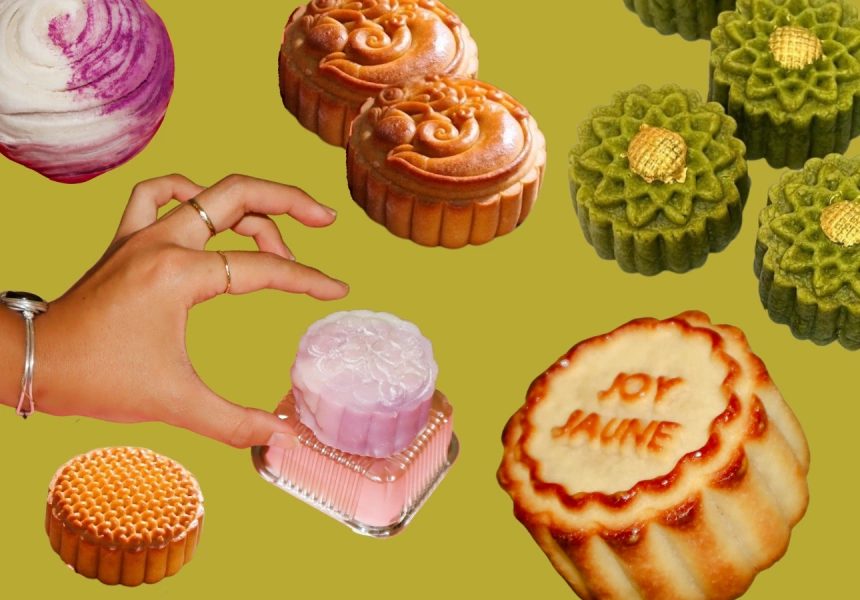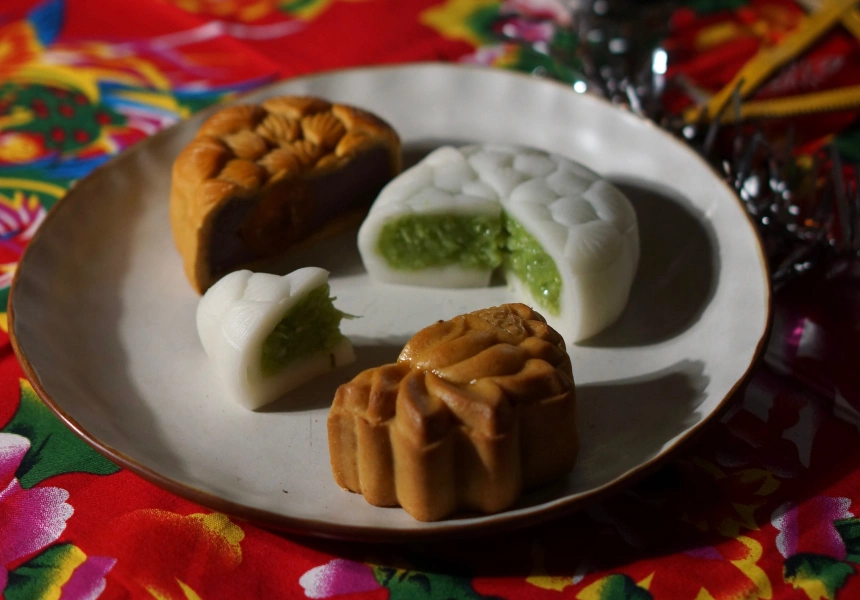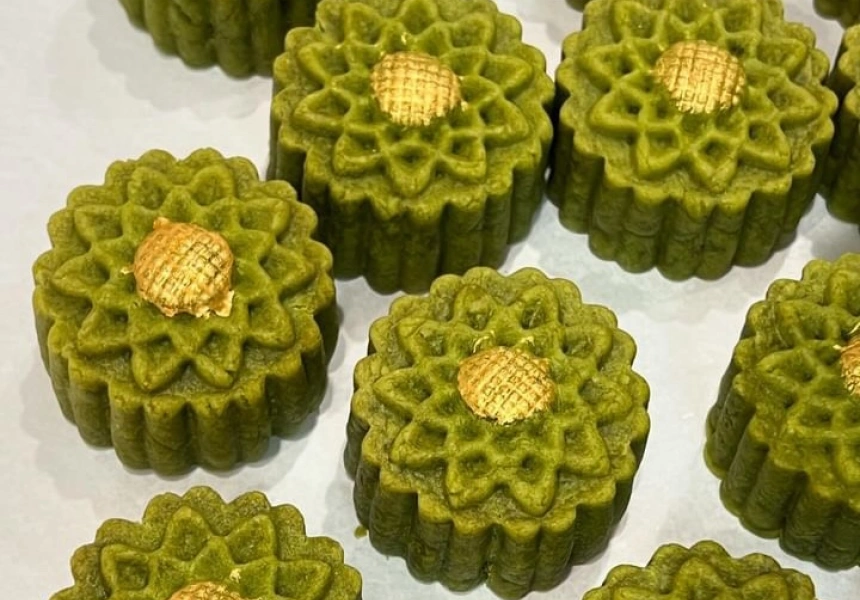It might be spring in Australia, but Mid-Autumn Festival starts on Tuesday September 17. Which means for much of the Asian diaspora, mooncake season has officially begun.
The harvest celebration originated over 2000 years ago and falls on the 15th day of the eighth month in the lunar calendar. Friends and families gather, light lanterns and often share mooncakes – a pastry that takes many forms.
The festival is celebrated in China and many other Asian countries, and mooncake varieties vary by region. They can be sweet or savoury, some are baked, and they’re traditionally made using wooden moulds – although modern creations usually use plastic stamp-like moulds that come in a variety of fancy patterns.
Get the best of Broadsheet first with Today – our free newsletter. Our expert editors curate the day’s most interesting and useful stories – new restaurants, must-see exhibitions, fashion trends, travel spots and more.
SIGN UPCantonese mooncakes – golden pastries filled with a lotus-seed paste and a salted egg yolk centre – are arguably the most common type you’ll see here. You can typically find them at Asian grocers and bakeries around the city. But mooncakes are extremely varied.
Here’s a guide to different kinds of mooncakes you’ll find in Melbourne, and the best places to try each one.
Hong Kong custard mooncakes
These treats were created in the Spring Moon Restaurant kitchen at the Hong Kong Peninsula Hotel back in 1986. Custard mooncakes are made using a European-style cookie crust rather than the pastry of Cantonese mooncakes.
Joy Jaune
Pastry chef Joey Leung of Preston Market shop Joy Jaune has been making mooncakes since she was a kid growing up in Hong Kong. Leung started making salted egg custard mooncakes to sell back in 2020, when the pandemic increased demand for the treats. This year, in addition to custard mooncakes, she’s making miso black sesame, Uji matcha and Uji hojicha mooncakes, available to be shipped or picked up from Joy Jaune
Chaoshan-style or thousand-layer mooncakes
Made using a laminated pastry that often contains lard or shortening, these flaky, spiralised pastries can be stuffed with sweet or savoury fillings.
Raya
Mooncake drops at Raymond Tan’s homey Malaysian bakery on Little Collins Street are almost as sought-after as new Supreme collabs. This year, Raya is offering six mooncakes: three Cantonese-style treats (filled with white lotus and salted egg yolk; Uji matcha and macadamia; and osmanthus pine nuts) and three flaky thousand-layer ones, which come in pandan coconut; red bean lychee; and Dubai pistachio kunafa chocolate, inspired by the viral Dubai chocolate bar.
Snow-skin mooncakes
These unbaked mooncakes are made by wrapping filling in a mochi-like skin made from glutenous rice flour.
Soon Guan Delicacies
Baker Chee Ying is the one-woman force behind Soon Guan Delicacies. Ying makes intricate flaky thousand-layer mooncakes, but her snow-skin versions, which get their marbled colour from natural fruit and vegetable powders, are standouts. They come in four flavours: matcha and adzuki beans; taro and cream cheese; lemon Earl Grey with white chocolate; and cookies and cream with sea salt.
Fellow Mart
This Instagram bakery specialises in pastel-coloured snow-skin mooncakes. The delicate cakes come in six flavours: durian, black sesame, matcha, chocolate, Oreo cheesecake, and red bean.
Shanghainese mooncakes
Shanghainese mooncakes are traditionally flakier than their Cantonese counterparts and are made using short-crust pastry.
New Shanghai
The Chinese restaurant chain makes ten sweet and savoury mooncakes. On the savoury side are options like prawn; nori, pork floss and salted egg yolk; and black truffle and pork. Sweet mooncakes include durian; lotus and salted egg yolk; and coconut, sweet red dates and pine nuts. They’re available at all locations.
Banh nuong
These Vietnamese mooncakes use a similar pastry shell to Cantonese-style mooncakes, but the fillings differ by region in Vietnam. Tung Nguyen, owner of Vietnamese dessert shop Che, tells Broadsheet that mungbean, and mixed nuts and Chinese sausage more typical of the north; black sesame and mungbean mooncakes more common in the centre of the country; and more fruity flavours and coconut are typically seen in the south.
Viet Thanh Homemade Cakes
Cook and creative Jessica Nguyen says it’s common for people who live in the west to drive to Springvale just to get mooncakes from this bakery. The shop has Shanghainese-style mooncakes and banh nuong with fillings such as durian, mung bean paste and taro.
Banh deo
These Vietnamese snow-skin mooncakes have a short shelf life due to their mochi-like skin. In the past few years, Tung says coconut and com (young rice that Tung says is similar in flavour to pandan, and “gives you a special texture, like a mix between glutinous rice and jasmine rice”) has become a popular filling in Vietnam, particularly in Hanoi.
Che
Nguyen’s Che sold 10,000 mooncakes during last year’s Mid-Autumn Festival. The dessert shop sells banh deo in addition to banh buong, which the team makes with three fillings: durian, black sesame and mung bean, and mixed nuts.
Meanwhile, the banh deo is filled with coconut and com. Che’s mooncakes are made fresh four times per week.
Taiwanese 3Q mooncakes
“Q” or “QQ” is a way of denoting texture. In Taiwan, Q is a sought-after texture that means a dish has a desirable bounciness (similar to well-prepared tapioca pearls in a bubble tea drink). 3Q Taiwanese mooncakes are named for the “Q” textured mochi that, along with red bean paste, pork floss and salted egg yolk, is wrapped in flaky pastry.
Amour Desserts
Er Rin Tan started making mooncakes when she emigrated from Malaysia to Australia in 2008 and struggled to find the high-quality mooncakes she was used to seeing back home. Tan’s Amour Desserts sells all kinds of mooncakes including snow-skin and Cantonese-style cakes with lotus seed paste and salted egg yolk. It’s also one of the only places in Melbourne where you can get Taiwanese 3Q mooncakes.
Additional reporting by Lily Beamish



